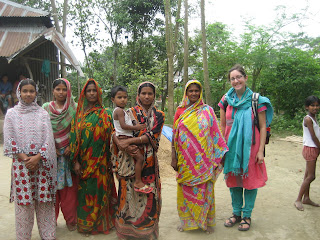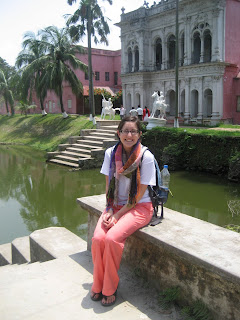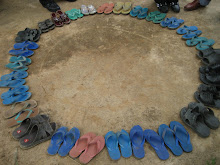As I’m chillaxing in the Dhaka airport, watching the lighting storm (which doesn’t bode well for my flight that leaves in two hours), I thought I’d share some of my thoughts as I’m leaving Bangladesh.
First, I want to comment on the stigma that comes with being a westerner here. I’ve struggled with being a foreigner in Bangladesh; the frustration usually comes in the form of feeling like a caged animal when hoards of eager Bangladeshis stare at me. Today, I experienced another “foreigner’s frustration” when I arrived at the airport. When I got out of the car at the airport today, there was an airport employee waiting for me with a luggage cart with my bags on it. I usually avoid letting people carry my bags for me, because I know they will try to take advantage of me by asking for a big “baksheesh.” Baksheesh literally means “gift,” but in practice, it often means tip. On my first day in Bangladesh, the young boy who carried my bags up to my room asked, in a heavy Bangladesh accent, “you gives my baksheesh?” I knew that he was asking for a tip, so I fished a small bill out of my bag. He looked at it, and then told me that he wanted more. I was embarrassed and found a larger bill for him. I was not quite as embarrassed later when I learned that this particular kid is a huge skeazeball and does this to every foreigner upon their arrival at the Grand Prince Hotel. So, today, I had a feeling that the same thing would happen with this creepy guy that wanted to carry my bags into the airport. I let him push the luggage cart to the door, and then he turned around and told me that he couldn’t go inside because he wasn’t a passenger, and then he asked me for money. I was prepared, and I handed him a TK10 bill, which is about 15 cents, but is a pretty standard tip for that kind of service. He then told me that he wanted TK100. So, I got pissed off, didn’t give him anything, and walked away. I was so aggravated that he tried to rip me off because I’m a foreigner. We’ve been dealing with being ripped off because we’re foreigners since day 1. When a cab driver quotes a price for foreigners, he literally doubles the price that he would charge locals. So, I now always try to get someone who looks Bangladeshi and/or speaks some Bangla to hail a cab for me. I have two Indian friends who speak little to no Bangla, but because they look South Asian, they are usually able to get a fair rate on a cab. When there’s a large group of white interns going somewhere in a cab, we literally hide while a pseudo-Bangladeshi argues over the cab fare with the driver. When we get the OK, we come out from hiding, and we can often tell that the driver is angry when he sees us that he didn’t get the chance to make some money off of the foreigners that will soon be in his cab.
Most Bangladeshis think that everyone in America is rich. On our village trips, we always asked the villagers if they had any questions for us. Number 1: What is your country? Number 2: Are you married? (And if the answer was no, they always tried to marry us off to someone) Number 3: Are there poor people in America? It was always the same progression of questions.
Beggars also ask for baksheesh. When we’re sitting in traffic in Dhaka, people walk through the streets selling random things (popcorn, oversized maps of Dhaka, light-up devil horns- it literally feels like I’m sitting in the stands at a baseball game). Beggars also walk through the streets, stopping at car windows to ask for baksheesh. When they spot westerners in a car, they come over as fast as they can, and stand there asking for money or food until the traffic starts to budge and our car pulls away. We persistently say, “Baksheesh nai,” but they don’t leave. When they roam through the aisles of traffic and see locals, they sometimes don’t even stop to ask for food. But, when they see foreigners, they spend plenty of time repeatedly asking us for money. We always encounter a ton of beggars in Dhaka traffic, and it’s really hard to continue to brush them off. In Banker to the Poor, Dr. Yunus talks about the beggars in Dhaka. He states that he makes every effort not to give anything to the beggars because that only increases their dependency on begging. Giving to beggars does not incentivitze them, and so a pragmatic, economic approach would be to ignore the beggars so that hopefully they search for an opportunity to stop begging. I have seen some sad things in the streets of Dhaka, and it is really, really hard to brush these people off. There are two girls that beg outside of the hotel every day, Rubina and Sharmin. Rubina is probably about 12 and Sharmin is about 7. They stand outside of the hotel every day, wearing the same tattered clothing, and asking passers by for food, water, or money. Sharmin is always happy to see the interns, and she says hello to us with Western hand gestures that various interns have taught her, including high-fives and the classic pound-explode. Rubina, on the other hand, has a much more somber demeanor. It’s really difficult to see such a young girl who has already suffered so much in her life. Some of the other interns often treat them to meals at the restaurant next to the hotel. Despite whatever the literature says, I think it is completely legitimate to blow off economic theory when it comes to Sharmin and Rubina. I’ve never seen a bigger smile than Rubina’s when we tell her to come in to the restaurant and someone orders food for her and her siblings. This is a kind, but also wise, gesture on the part of my fellow interns. Darshan, my friend who frequently treats these kids to lunch, always says that he wants them to come in to the restaurant, wash their hands, sit at a table, and enjoy their meal. He is very adamant that they remain inside to eat, because he wants them to be treated like the humans that they are, rather than eating their food on the curb. Forget disincentivizing them, the most valuable thing we can do for Sharmin and Rubina is to show them some love.
Moving on… I had a really awesome conversation with one of the emirates employees at the airport. I greeted him in Bangla, and in typical Bangladeshi fashion, he then assumed that I spoke bangla and started talking to me in the language. After clarifying that I only speak a little Bangla (kitchu-kitchu), he then proceeded to chat with me about my experiences in Bangladesh. I came to find out that he is a social worker who works with an international NGO that just secured funds to build a shelter on the coast to aid victims of cyclone Sidr. Anyway, he asked me some thought-provoking questions about Grameen. He first asked me if I thought Grameen was unique. I told him that no, I didn’t think Grameen was unique, and I told him that BRAC and other NGOs have similar programs. As I’m sitting here now, I realize that Grameen is in fact unique, even if their microcredit operations are not. Grameen is definitely a unique organization, in that they’ve received the most intentional recognition for their work with microcredit (whether they deserved the attention is a different story). He then asked me if I liked my internship. I had to really consider how I wanted to answer this question before I started speaking. Did I LIKE my internship? I wound up telling him that I found it a very informative and rewarding experience, but is that true? My internship with Grameen was informative, I suppose, but I still don’t know if anything that the Grameen staff members told me was true. Yesterday, I found out that the Grameen staff members who preside over center meetings (called center managers) get fired if they don’t achieve a certain repayment rate. So, the center managers will repay the loans for the borrowers if they can’t afford to make their installment. When I learned this, I was shocked. It was one of those moments where you feel like your entire belief system has been challenged. I know that’s irrational of me, and I know that this probably doesn’t happen very often, but still, I was in disbelief.
And now I’m sitting in the Houston airport drinking a margarita (=pure bliss. The guy asked me if it was good and I told him that I’d been in a Muslim country where alcohol is illegal for the past month so it was perfect). I’m so happy to be back in the US- no one is staring at me, I don’t have to speak broken English in an Indian accent to be understood, and there are sports besides cricket on TV.
So back to what I was talking about before my brief 30 hour hiatus… being a foreigner in Bangladesh. I got “randomly” searched at both of the checkpoints in the Dhaka airport. I’ve never been selected for one of the random searches in my entire life, and although I was definitely the minority in the airport in Bangladesh, it still caught me off guard. Being foreign usually has the opposite effect on people in stores and such- when we go to the super market Agora, they never check our receipts when we walk out of the door. But, for all of the Bangladeshis, they always check to make sure that they aren’t shoplifting when they walk through the doors (p.s. just heard some sort of horn from outside the airport and I thought it was the beginning of the call to prayer- I’ve been in Bangladesh for too long).

As I wrote in my final report that I turned in to Grameen, my main goal and objective in coming to Grameen was to observe the way microfinance works on the field and draw my own conclusion regarding whether or not it works. Although I’ve seen and learned about a lot of faults within Grameen and microcredit in general, the moral of the story is that Grameen has helped a lot of people. Whether or not they’ve helped 15% of their borrowers or 75% of the borrowers cross the poverty line is another question. But still, as one of my fellow interns said, even if the Grameen Bank only does 20% good, it is still worth it for those people that it helps. My final conclusion is that Grameen has a lot of structural faults and there are definitely logistical changes that need to be made, but the microcredit should still be employed as a means of poverty alleviation. It does work, but for microcredit to be successful in its true form, it needs a very specific kind of borrower. The kind of person that would achieve success with a microcredit loan is someone who is moderately poor, has some sort of marketable skill, and has some formal education and/or business sense. This is a pretty narrow window, and there are many Grameen borrowers who do not fit this mold, which is probably why a lot of borrowers are unsuccessful. I don’t think Grameen does a great job of weeding out borrowers that are potentially unsuccessful, rather, they just “help” them struggle through they system once they are a borrower. It is a fine line to walk though, because undoubtedly there are people who do not fit this mold initially, but they are able to step up to the plate and run a successful business when they are given the guidance and support of the Grameen staff members and their fellow borrowers. The Grameen program for the ultra-poor (beggars) has not been very successful. The premise for that program is that beggars are given a loan and they repay with no interest, at their own pace. I think this is a balance of incentivizing them and cutting them some slack. The incentive for the beggars to pay back is that they are able to take another loan when they pay back the first, and when they are able to make a certain installment per week, they can enter the “credit highway” that is so esteemed among Grameen basic loan borrowers.

Grameen tried to do a really good job of covering up all of the negatives about the way they run their business. They managed to present us only within shining success stories from Grameen borrowers, but we’re not stupid; we know that that’s not the whole story. The guy who I spoke with in the airport also asked me what I thought about microcredit in general. He said that he’s heard that Grameen charges interest rates that are too high and the run their business like a profit maximizing business rather than like a social business. I can definitely get behind this theory- the interest rate at Grameen is 20% reducing, which comes to about 15% yearly, I think. All of the other MFI’s have similar interest rates, all between about 11% and 15%. This is one main criticism of microfinance, and in this context, one can argue that microfinance takes advantage of the poor just like loan sharks do. Another big criticism of the Grameen Bank, in my opinion, is that they haven’t embraced the “credit-plus” notion in the way that BRAC has. BRAC boasts pretty successful schools, health clinic, and other health education programs. Grameen has tried many of these programs, but they have not been very successful, and none of them are sustainable. The BRAC health care clinics are, I think, almost completely sustainable. The problem with many Grameen programs is that they are donor funded, and when the funding runs out, they are done. For example. Grameen is doing a great pilot primary school program right now. They targeted the kids in the slums of Dhaka that are often forced to work for their parents, either at home or some real child labor type work. So, they cannot go to school for the whole day because their parents need them at home. This school program was for three hours per day, but I was impressed by the kids- at least, their spoken English exceeded my expectations. However, the program is only a five year pilot program, so one group of kids is going through all five years of primary school education in the Grameen Shikkha program, and then they will hopefully begin government school. But, the program is done at the end of 2010. BRAC’s primary schools have a similar target audience, but they are not a pilot program. I don’t remember if they are donor-funded or not?? Anyway, I think that Grameen boasts that they have a lot of sister organizations that are helping the poor in many other ways, and in some ways, that is true, but for the most part, I was not very impressed by their sister companies. Grameen Shakti (power) was impressive, but it is still pretty expensive, and it’s hard for some villagers to see the value in getting solar panels for their house, when they already have electricity in their houses (well, except for the few hours per day that their power will most likely go out).

Another fault that I saw in the microcredit system is the perpetuation of gender roles. As I’ve said, Grameen empowers women to a certain extent by giving them the money and some means to meet their basic needs, but it doesn’t go any further. The gender inequality is more blatant in other organizations; in UDDIPAN for example, the biggest loan that is available to women is tk 15,000, while men can take out an enterprise loan for about tk 50,000. Even though the in the case of most Grameen borrowers, women take out the loan and men actually use the funds, at least the Grameen system gives the women physical access to money. It is hard to say what Grameen could do to encourage gender equality, especially in a heavily Moslem society, where women are definitely not equal. They’ve taken some steps; for example, they encourage borrowers to educate all of their children equally and they discourage the practice of dowry, but there’s a long way to go.
I’ve learned a lot, gotten an increased tolerance for unpleasant situations, and gained a new appreciation for what I have. And, because I have been asked a few times: here are some of the things that I missed the most when I was in Bangladesh: running, peanut butter, cheese, constant electricity, air conditioning, and wearing shorts/not wearing a scarf. But, more importantly, there are a lot of things that I’ll miss about Bangladesh, including mangos, “no problem,” cha, paying less than 1usd for a meal, rickshaws, and all of the amazing people that I met (including Mr. Sabur and Mr. Babur…).













